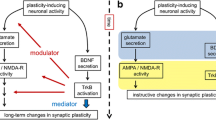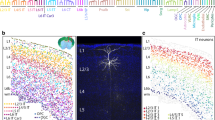Abstract
AMONG ‘peculiarities of uncal hippocampus’ revealed by silver-sulphide impregnation I have elsewhere1 reported the presence of zinc-rich synaptic bags, of a smaller order of magnitude than in the main hippocampus, extending from CA4 into the inner molecular stratum of the fascia dentata and within the ‘tail’ of the end-bulb of the mossy fibre system in the guinea pig. There is one further hippocampal region, remote from the uncus and from the mossy fibre system, that exhibits similar smaller-order zinc-rich synaptic bags. It extends as a narrow zone, readily seen in well-impregnated transverse sections under medium magnifications (Fig. 1), from the apex of the subiculum along the junction of alveus and stratum oriens over the whole length and breadth of CA1. Higher magnifications show that, whereas in subiculum proper lighter brown synaptic entities outline alveo-perpendicular apical dendrites, in the alveo-oriens zone darker-impregnating entities outline dendritic processes that are multipolar and weave a loose alveo-parallel network. The somata of origin of these skeining dendrites can be ascertained by counterstaining, rather indefinitely in most normal preparations, but confidently in certain pathological circumstances (to be described elsewhere). They lie within the network, leaving little doubt that they are the somata of the ‘horizontal neurones’ displayed in this zone by Golgi methods. Golgi preparations reveal no conspicuous axonal swellings or dendritic spines in this neighbourhood and show most of the horizontal dendrites to lie distal to the terminal bushwork of the basal dendrites of the CA1 pyramidal cells. Hence, the zinc-rich entities here would seem to be most probably axo-dendritic synapses with ‘axon terminals’ of the intermediate type defined electronmicroscopically by Blackstad2, the axons concerned being presumably CA1 pyramidal ones before they are myelinated, or collaterals thereof, since the synaptic entities are shrunken here after ‘selective ablation’ of CA1 pyramidal cell somata by hypoglycæmic seizures, much as in the end-bulb3. Further electron-microscope, as well as enzyme, investigations are obviously needed in this realm.
Similar content being viewed by others
References
McLardy, T., Progress in Brain Research, 3 (Elsevier, Amsterdam, 1963)
Blackstad, T. W., ibid.
McLardy, T., Nature, 195, 1315 (1962).
Gloor, P., Sperti, L., and Vera, C. L., Electroenceph. clin. Neurophysiol., 15, 379 (1963).
McLardy, T., Perspec. Biol. Med., 2, 443 (1959).
Andersen, P., Eccles, J. C., and Loyning, Y., Nature, 198, 540 (1963).
Van der Loos, H., Twenty-second Intern. Cong. Physiol. Sci., Leyden (1962).
Von Euler, C., physiologie de l'hippocampe (Centre Nat. Rech. Sci, Paris, 1962).
Author information
Authors and Affiliations
Rights and permissions
About this article
Cite this article
MCLARDY, T. Second Hippocampal Zinc-rich Synaptic System. Nature 201, 92–93 (1964). https://doi.org/10.1038/201092a0
Issue Date:
DOI: https://doi.org/10.1038/201092a0
- Springer Nature Limited
This article is cited by
-
A Timm-Nissl multiplane microscopic atlas of rat brain zincergic terminal fields and metal-containing glia
Scientific Data (2023)
-
Light microscopical mapping of the hippocampal region, the pyriform cortex and the corticomedial amygdaloid nuclei of the rat with Timm's sulphide silver method
Zeitschrift für Anatomie und Entwicklungsgeschichte (1974)
-
Distribution of heavy metals in the hippocampal region of the guinea pig
Zeitschrift f�r Zellforschung und mikroskopische Anatomie (1974)
-
Effect of diethyldithiocarbamate (DEDTC) on sulphide silver stained boutons reversible blocking of Timm's sulphide silver stain for “heavy” metals in DEDTC treated rats (Light Microscopy)
Experimental Brain Research (1973)
-
Effect of intravital dithizone treatment on the timm sulfide silver pattern of rat brain
Histochemie (1971)





